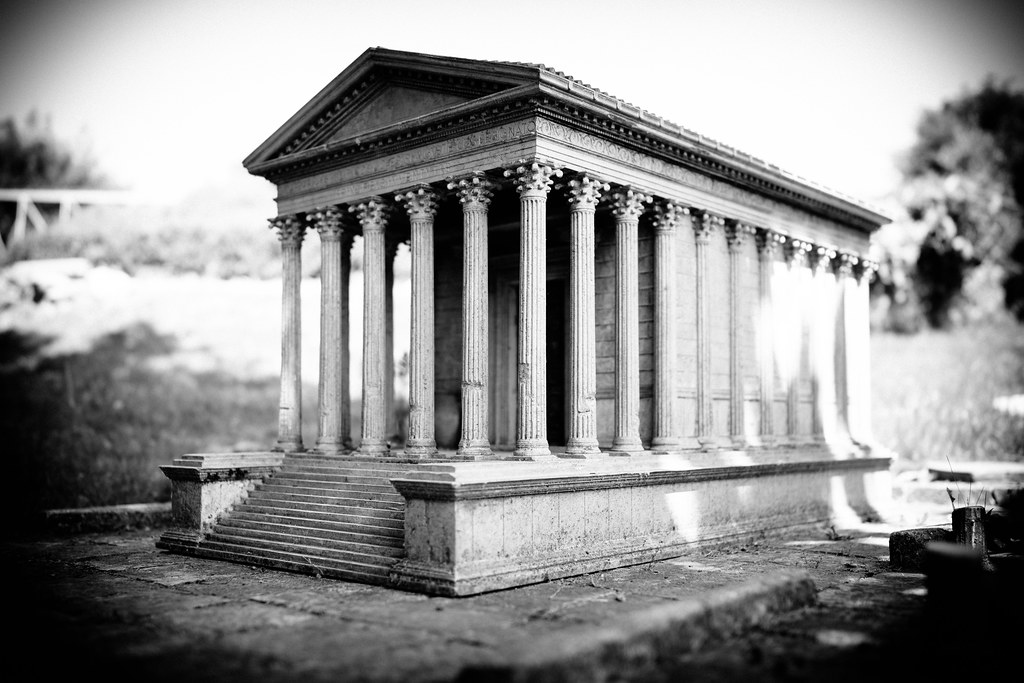#hexastyle
Text
rubias
SHEMALE DILDO ENORME
Desi bhabhi xposing her boobies
Girl masturbation and dripping pussy Compilation
sodomie en douceur avec mon nouveau joujou
Dos jovenes colombianos anal sexy, quieres mas apoya el video y subire mas
Gracious boy got a nice surprise from his teen friends
Luis Figo daughter sex tape
Black Dick Sliding in Tight White Pussy
Hard anal
#alate#Caliburno#timework#redemptor#womps#bowpot#cassina#artistical#rebukingly#strandline#hexastyle#medakas#asking#liverance#paramedical#airmail#blakeberyed#eremitic#priapismic#bedirty
1 note
·
View note
Text
Esposa safada do amigo
Young whore fucking with husband and gets hot cum
Shemales fucks a gay xxxx
Pretty busty slut rides huge cock
Student with webcamshow with double penatration and squirt with Ohmibod in pussy
Hot stepmom Cherie DeVille licks Chloe Cherrys teen pussy
Girlfriends Teen caught fingering fucks friend doggystyle with big strap on
drkanje sa svrsavanjem
Tgirl babe fucks ftm transsexual
Close-Up Butt Plug In Big Ass Amateur Milf, Big Cock Penetrates Wet Pussy, Ass Filled With Cum
#rials#Edenton#point-blank#portague#alate#Caliburno#timework#redemptor#womps#bowpot#cassina#artistical#rebukingly#strandline#hexastyle#medakas#asking#liverance#paramedical#airmail
0 notes
Text
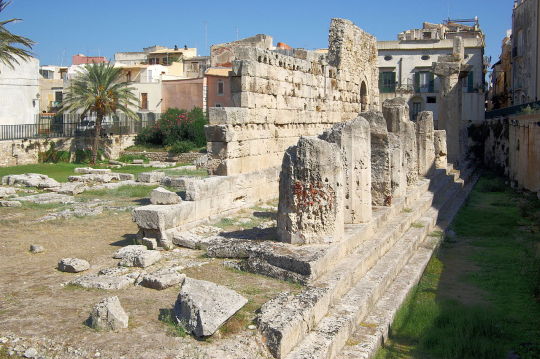
Photo credit: Berthold Werner
Temple of Apollo in Ortigia, Syracuse (Sicily)
If you ever happen to be in the center of Ancient Ortigia, which lays in the oldest part of the city of Syracuse in modern Sicily, don’t miss out on visiting the ruins of the temple to Apollo, built there in the beginning of the 6th century BC.
At the time, Sicily was under Greek rule, having been colonized for about two centuries. Thus, the temple has a significant influence brought in by Greek sculptors - in fact, it is the oldest Doric temple in Sicily. This type of temples, called peripteral temple where the columns surround the entire structure, has quickly become common across Eastern parts of Greece, too. It’s possible that the inspiration roots in the temple of Apollo in Corinth.
This monumental stone structure has gained quite the history over the time of its existence: it was used as a Hellenistic church, a Byzantine church, an Islamic mosque (there are Arabic inscriptions on the walls), Norman, and even Spanish church. It happened over the very long period of the Sicilian land being conquered and colonized by various powers. The consistent changes as to how the building was built caused noticeable damage to the structure. It’s only in the beginning of the 20th century that the temple was finally cleared and opened to view.
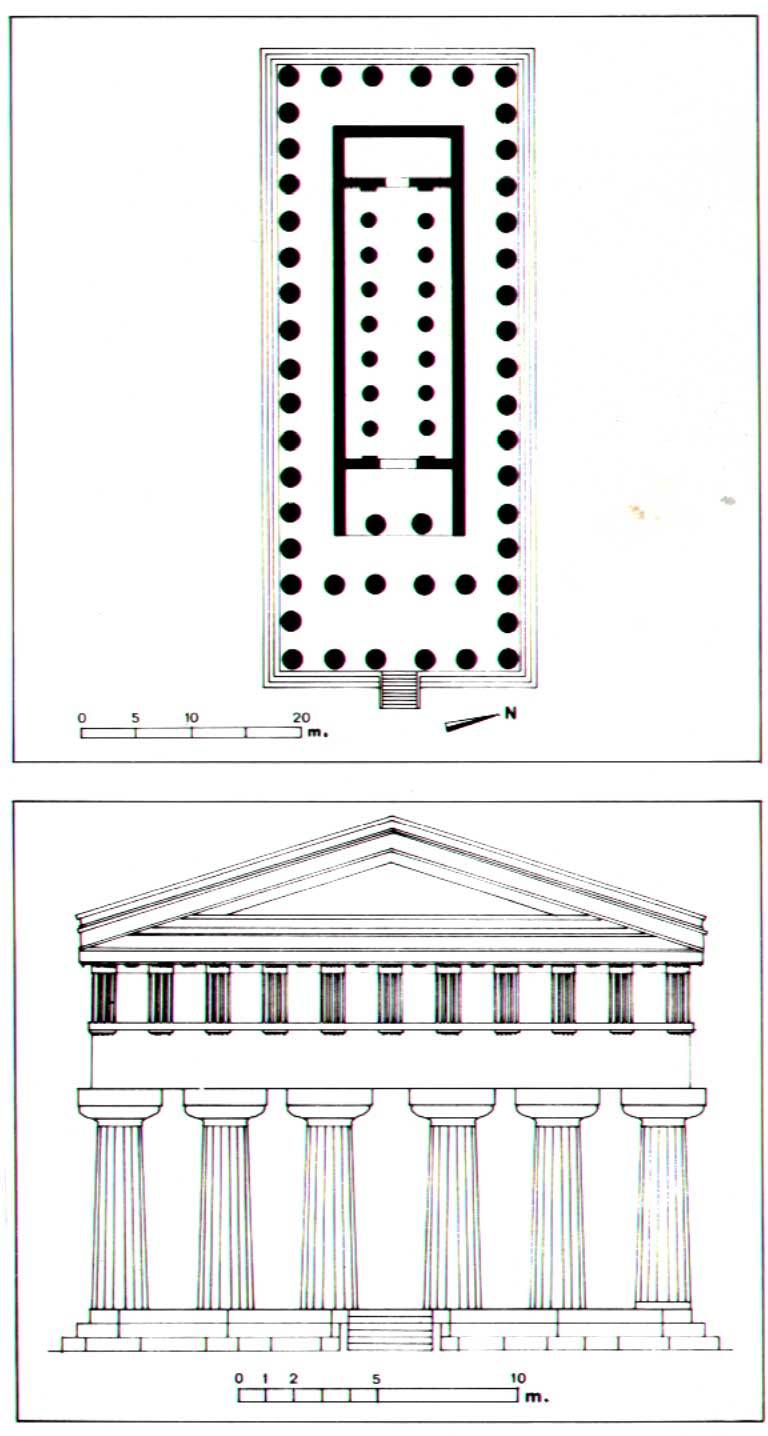
Plan of the temple.
The temple itself measures 55.36 x 21.47 meters at the stylobate, with an arrangement of 6 x 17 columns of rather squat proportions. The front is hexastyle, meaning that the portico has six columns, and there’s a continuous collonade surrounding the pronaos and the cell, which was divided into three naves with three slimmer collonades inside. There is some evidence that the roof of the temple was wooden, though it’s hard to reconstruct. The architrave, part of the roof resting immediately atop the columns, was also wooden, which was a common part of Sicilian architecture of the time. It is possible that inner columns of the temple were meant to hold up the roof. This, as some researchers admit, would be quite a difficult structural feat to complete.
The back of the cell of the temple had a closed compartment called adyton or adytum, which was used to hold the cultic image of the Deity and wasn’t supposed to be entered outside of religious services. This is a very typical Siceliot detail that temples across Eastern Greece have quickly acquired.

There were in total 46 columns made out of stone and it is highly likely they were transported to Sicily by sea. The enterprise must have been exceptional to the builders themselves as there is an inscription on the back of the temple celebrating the event. On the East side of the temple, near the steps, one can read a 8 m long inscription in Attic Greek that reads, transcribed with difficulty: Kleomenes son of Knidieidas made the temple to Apollo, and Epicles made the colonnades, beautifully done.
It is possible that the temple was also dedicated to Diana, as Cicero notes. This wasn’t an uncommon happening: the Twins were often venerated together, and it was a done thing that the temple of Apollo belonged to Diana, and vice versa.

Right now, not much of the temple is preserved. A section of epistyle on the Southern side alongside two columns is preserved, and so is a part of the wall of the cell. The Western side is still in restoration. The building was primarily made out of blocks of sandstone, which might explain why it hasn’t lasted for as long as some other structures. We can also still see some of the inner decor preserved in the regional museum Paolo Orsi:


The temple of Apollo of Syracuse was likely built in close vicinity to the temple dedicated to His son Asclepius. This is hinted at by the findings near Piazza Pancali, where two statues were excavated - one for Igea, Divinity of hygiene and medicine, and one invoking a doctor, possibly attributed to Asclepius.
🏺 🏺 🏺
#apollo#ancient sicily#ancient greece#ancient architecture#sicilian history#temple of apollo#HISTORIA 📔
28 notes
·
View notes
Text
Wednesday 31 July 1839
7 20/..
11 25/..
fair but dull – F67 ½° at 8 am – breakfast at 8 40/.. to 9 ¼ - waited for carriage – out at 9 55/.. to the castle – sent back our new guide at 10 8/.. who brought the carriage at 10 ½ - fine view from the castle of town and fiord – took the carriage up the hill the road we came to see the view –
4sk. paid the woman at the house where we alighted on coming away at 11 ½ - at the Palace at 12 10/.. – Hexastyle portico, and hall opening on to the top of it 20x115 yards – handsome room at the back of the staircase – columned – a Saxon at work at the Scagliuola [Scagliola] pilasters – ceilings boards and 2 layers (crossing each other) of reeds put on with wire – floor-boards 1 ½ in. thick battens – came away at 1 20/.. – at the Botanic garden at 1 40/.. – called at [Vonkowskys] – plenty of guides – then to Hoppe’s for pencils English for A- and sent off the carriage at 2 50/.. from Hoppes’ door and walked home for 2 pencils English 40sk.
July 30 – Botanic garden well arranged and very pretty ground –
Veratrum nigrum
Epilobium angustifolium (contamine)
numerous [genus] study it –
Rumex acetosum [acetosa] sorrel – study this genus.
Saxifraga longifolia (the tall S. of the Pyrenees?)
S. geum. London pride.
S. crassifolia
S. crassifolia cordata
the pink thing in the walk (Johns’ garden) at Shibden
Dianthus latifolius (Sweet William)
Linaria stricta and vulgaris (common yellow snapdeagon)
Lotus. the yellow butterfly flower on the little field brow at home that grows with the potentilla
Solidago gigantea, Golden rod.
vaccinium myrtillus, bilberry?
v. uliginosum (cloudberry?)
came in at 3 ¼ and sent off John Johnston our new guide to get his dinner till till 4 ¼ - A- had some of our Deventer gingerbread – excellent – warmed her stomach – left her lying on the sofa and went to Vonkowskys’ at 3 ¾ - no! rain and went at 4 ¼ - Mr. Jäger much recommended Mr. Smith – satisfied with S- at 2 ½ species a day – brought him home with me – paid the bill 2.8.0 including the 8sk. for the coachman carriage charged 5 hours – at 5 5/.. A- and Mr. Smith and I went to the coachmaker to see about the carriage – home at 5 ¾ - saw Johns’ foot – very bad – dinner at 6 ¼ - Had Messrs. Smith and Jäger from 8 to 9 and the medecin [médecin] Kallevig to see John’s foot –
SH:7/ML/TR/12/0014
John’s foot a thing of old standing – A- and I had coffee at 10 – fine day but heavy shower at 3 ¾ for 20 minutes
1 note
·
View note
Photo
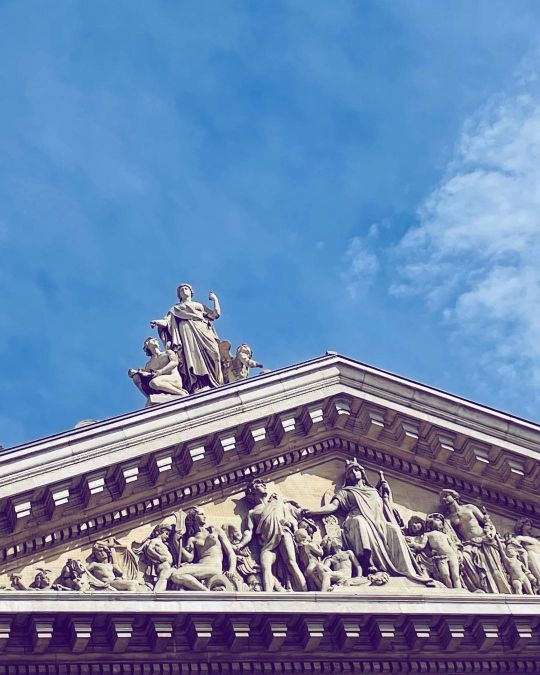
Brussels Stock Exchange: The old La Bourse de Bruxelles building is the stock exchange of Brussels. The grand old lady of Brussels is a staggeringly beautiful classically inspired building. The front of the building is especially with it's classically Greek hexastyle portico topped with a highly ornate pediment with sculptures. The building is of course no longer used as a commodities exchange and not mainly hosts exhibitions. On the day I visited, there was an exhibition on capitalism, mostly informative for visitors to make up their own mind about this socio-economic system. The exhibition was mostly in French or Dutch, but there was a leaflet in English which was not as verbose as the aforementioned languages. #brussels #europe #travelwithshlok #himography (at Brussels Stock Exchange) https://www.instagram.com/p/Cgj6hoahzK6/?igshid=NGJjMDIxMWI=
0 notes
Photo
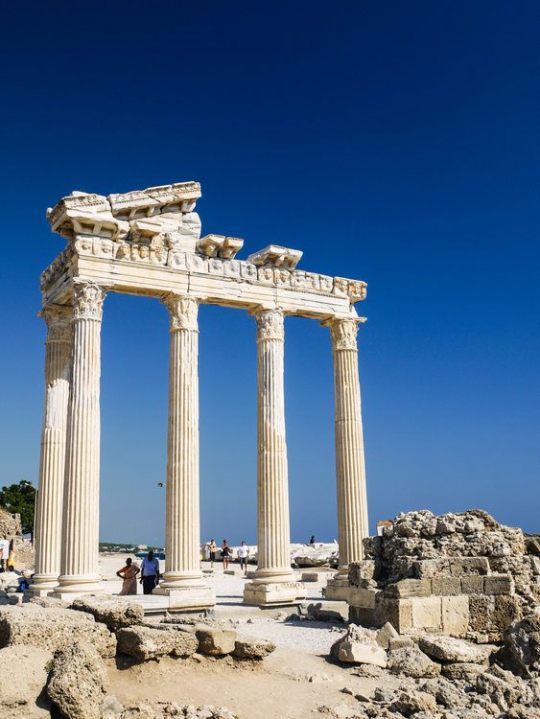
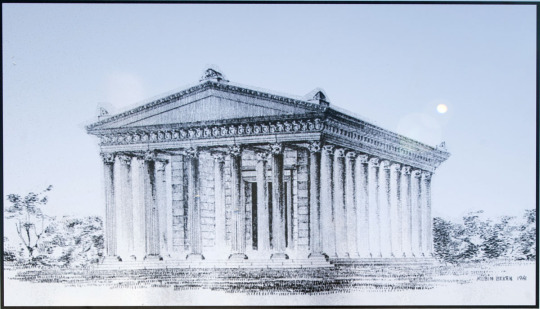

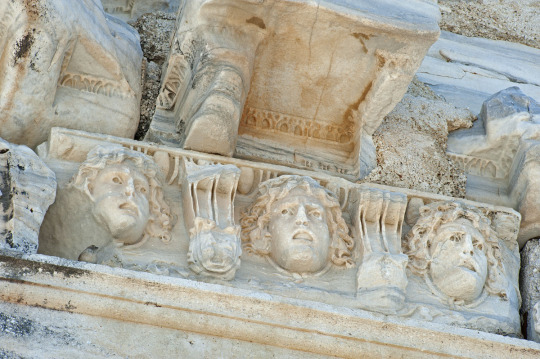




Temple of Apollo
Side, Asia Minor (Turkey)
2nd century CE
The Temple of Apollo is a hexastyle Corinthian temple in Side, Turkey. It originally had 6 front columns and 11 side ones. 5 of its columns were re erected in modern times. What made it different from other temples of that era, is its antechamber which had a pair of massive Corinthian columns. It is believed to be the place where Anthony met Cleopatra; he presented the Apollo Temple as a token of his love and devotion to her.
From an architectural point of view, this temple was a peripteros i.e. it was surrounded by a colonnade on all four sides of the inner chamber (called cella or naos). In the case of the temple of Apollo this colonnade was executed in the Corinthian order. Each longer side of the building was originally adorned with 11 columns and both shorter sides were decorated with 6 columns.
The stylobate of Apollo's temple, that is the top step of the platform on which colonnades of temple columns were placed, has the dimensions of about 16 meters (52 feet) by 30 meters (98 feet). Five columns that are currently standing were re-erected as part of the reconstruction work carried out in the 80s of the 20th century under the supervision of Professor Jale İnan. The frieze placed above them depicts the heads of Medusa - a mythological monster that had the face of a human female with living venomous snakes in place of hair.
The two main deities of Side in Roman era were Apollo and Athena. One of the two temples built in Side during the period known as the Roman Peace is the Temple of Apollo. Apollo is known as the god of music, poetry, sun, and light in Roman mythology. The other temple constructed in this period is the Athena Temple built in the honor of Athena, the goddess of wisdom and skill. These two temples lie close to each other on the tip of Side peninsula.
It is believed to be the place where Anthony met Cleopatra; he presented the Apollo Temple as a token of his love and devotion to her. (according to a local legend, and not backed by any account)
Sources: 1, 2, 3, 4, 5, 6

#art#Architecture#travel#history#roman#roman art#roman architecture#temple#apollo#mythology#Roman Mythology#temple of apollo#hexastyle#corinthian#side#turkey#Anatolia#Anatalia#asia minor
691 notes
·
View notes
Text

A MONUMENTAL BRONZE AND METAL BIRD CAGE OF PALLADIAN FORM.
The hexastyle portico with a pediment centred by the Royal Arms of Queen Victoria.
The six Corinthian-columned portico surmounted by a triangular pediment is inspired by the façade of Mansion House, the official Lord Mayor's residence in the City of London built between 1739 and 1752 by George Dance the Elder.
Sotheby’s
48 notes
·
View notes
Text
FORUM ROMANUM VI
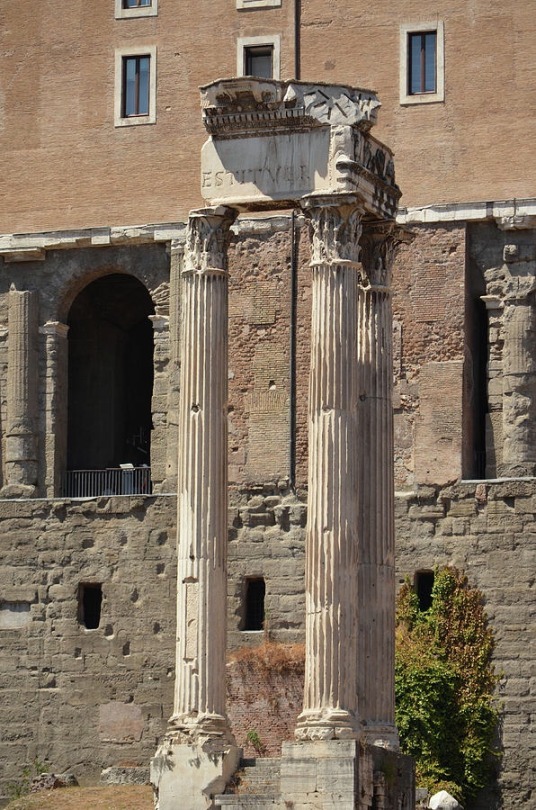




TEMPLUM DIVI VESPASIANI
The Temple of the Divine Vespasian was begun by Titus after the death of Vespasian in AD 79, but finished and dedicated by Domitian after the premature demise of Titus in AD 81. Some scholars have hypothesized a dual dedication to both the deified Vespasian and Titus. The inscription on the architrave (recorded in the Einsiedlen Itinerary), however, cited Vespasian only (DIVO VESPASIANO AVGUSTO S. P. Q. R.). The Temple of the Divine Antoninus Pius and Faustina cites both dedicatees in that temple’s surviving inscription, which suggests that Titus would have been mentioned had his cult been established in the same temple as his father’s. The omission of Titus may attributed to Domitian’s hostility towards his brother or to the fact that Titus’ death had been commemorated in the Forum already by the arch bearing his name.
The Temple of the Deified Vespasian is sited in the highly-congested western end of the Forum Romanum, between the Temple of Concordia and the Temple of Saturn. When complete, it nearly abutted the Tabularium and obscured much of its façade. The previous temples of the imperial cult, dedicated to Augustus and Claudius, had been built outside the forum where sufficient land allowed for the construction of imposing edifices. The Flavians, however, chose this chose this cramped space in order to establish a dynastic presence in the Forum. The temple would also serve as a counterweight to the Temple of the Deified Julius Caesar, which stood at the eastern end of the Forum, and to the other monuments built by the Julio-Claudians. The site did have one advantage: located at the foot of the Clivus Capitolinus, the temple was highly visible during triumphs and other civic ceremonies that terminated on the Capitoline Hill.
The temple is hexastyle, prostyle and pseudo-peripteral. It stood on a high, marble faced podium and had a façade orientation. The odd proportions of the temple (33 m x 22 m) were dictated by the area available. The scant physical remains consist of the podium, three fluted Corinthian columns supporting a section of the architrave, and, inside the Tabularium, a large chunk of the entablature.

The latter is virtual compendium of Roman decorative motifs including dentilation, egg and dart, rosette coffering, brackets, and a large frieze depicting bucrania and the implements used by the priests of the temple in the performance of sacrifices. Dense, ostentatious ornamentation is a hallmark of Flavian style, perhaps reflecting desire of the usurping dynasty to project an image of richesse.
A second inscription, also preserved in the Einsiedeln Itinerary, appears on the architrave, the final word of which is still extant:
IMPP. CAESS. SEVERVS ET ANTONINVS PII FELIC[ES] AVGG. RESTITVER[ENT]
Archaeological evidence suggests that the restoration of the temple around AD 200 by Septimius Severus and Caracalla was minor act undertaken for its propagandistic value of linking the Severus to the previous—and highly-admired—usurper, Vespasian.
The temple was largely demolished by Nicholas V as part of his reorganization of the Forum Romanum.
FORUM ROMANUM SERIES
I. Arch of Titus
II. Lacus Juthurnae
III. Arch of Septimius Severus
IV. Tabularium
V. Basilica Iulia
VI. Templum Divi Vespasiani
111 notes
·
View notes
Text
Sunday 15 September 1839
[Sadly, the bugs did bite Ann the previous night. But she is rewarded by the finest view she has ever seen, the bay of Vyborg, and sketches its fortress. Meanwhile, Anne is appreciative of the local costumes and food, and as usual entranced by the botany and geology. She even tastes the local seawater! Anne’s trusty parasol comes handy in scientific enquiry, not for the first or the last time. Her own sketch, of a bridge, is, uh, not very accomplished, but the engineering detail is recognisable. As ever on this overland trip to St. Petersburg, which is nearing its end, Anne writes and writes and writes, and this day’s entry is *very* full of researchable detail, including a stately home they pass by, which is perfectly identifiable from her notes, and which has a slightly tenuous lesbian connection...]
[up at] 4 3/4
[to bed at] 10 1/4
Damp morning Fahrenheit 60 1/2º at 5 a.m. I am all ready now at 5 35/” no coach house therefore paid for man watching the carriage last night -/50 and paid Gross this morning for paid yesterday for ditto ditto – -/50 – with all the exertion I have made it is 6 3/” when we get off – 3 minutes later than the time – damp hazy morning – forest immediately on leaving the station neither of us slept well last night – Ann much bit – we had nothing but plates and cups and saucers and knives and forks and table linen and our one double bedded room and servants room and paid 4/20 – Scotch fir this morning barked all round for a yard or 2 from the ground at 6 20/” little distant left fjord or lake – road red coarse as yesterday sandy but good tho’ much rain in the night – forest and little breaks all the way to Säcjarvi at 7 1/2 a lone house in the forest – small but goodish – as the gentleman said yesterday at Högfors one might sleep at
Nisalak 15 1/6 v[ersts] Helsingfors 237 v[ersts]
Urpala 16 4/6 v[ersts] Wiborg 44 1/2 v[ersts]
St. Petersburg 181 v[ersts]
Säcjarvi but Urpala seems a good deal the better of the two – same sort of forest and road as yesterday but less population and boulders not so strikingly large – the soil here a fine red gravel as yesterday and many examples of gravel-conglomerate boulders – more cattle this morning than ever before since Åbo – no sheep today as yet – so few in those northern countries can only be just enough to supply the inhabitants with wool and a little cheese and mutton – they salt the legs (the hams) for winter – the Russian male costume this morning very pretty and picturesque a white frock coat and red belt – or blue or dark and often bound with the same – the women wear a strong linen? dark with narrow red stripes for petticoats and a boddice a jacket . . . and a white handkerchief on the head – they all weave the red striped stuff – and I have seen many men wear it for jackets and trowsers
8 25/” several baggage little waggons and 1 horse and some soldiers on foot now at 8 25/” just crossed little bridge over little stream and crossed a broader stream some time ago the only two streams this stage so far – the forest too less swampy than the forests yesterday at 8 3/4 considerable break in the forest – unpainted hamlet (we pass thro’) – one of the largest flocks of sheep we have seen (recently shorn) – log houses the trees not flattened big boulders all among the cottages – peasants wear black leather gloves like our hedging mittens – hardly out of the hamlet before the young forest begins again (Scotch fir and birch, alder bushes everywhere in the swampy places) – but more break, and fields another hamlet (scattered) at 8 55/” and at 9 over neat little ochre-yellow and white-seamed station house at Nisalaks the older portion of the house under the same room unpainted flattened log-house – breakfast boiled milk and Wiborg (criks?)
Wiburg 29 2/6 Helsingfors 252 1/2
Säcjarvi 15 1/6 St. Petersburg 165 5/6
Kiskila 14 1/6
bread tied up in a sort of rose – and made tea, and took my pint bottle full away with us – all ready at 10 – off at 10 20/” from Nisalax we should have lived better here than we did at Urpala, I suspect – nice little station – a little meat on the fire boiling when we came in, and our milk ready in 10 minutes or 1/6 hour – In 5 minutes pass thro’ the little hamlet – and then rocky forest and big boulders again road coarse red sandy as before but good – forest, till 11 1/4 good river – 2 or 3 good wood yellow painted houses scattered about and little unpainted scattered hamlet – nice bit of open cultivated country – then road red sand (but good) and the soil red sand – still damp and rather hazy – (Reading Handbook article Moscow) – soon forest again – at 11 3/4 look down upon beyond us (left) the handsomest gentleman’s house we have seen in Finland, surrounded with park-like grounds – little hamlet scattered hereabouts – house and 2 wings – white with pea green roof – at 11 51/” our neat good yellow and white pilastered station at Kaskilä and broad sheet of water at a little distance – front – another pavillion-like gentleman’s house almost in front (to the right) from our station yellow with pea green roof and white corners and a white hexastyle portico (with pediment – the gable end) fancifully painted coach houses and stabling and unpainted barns and cottages scattered about the fine sheet of water coming close to the house – very pretty
Wiborg 15 1/6 Niserlax 14 1/6
St. Petersburg 153 2/3 Helsingfors 266 ½
hue – our stage last night to Urpala very picturesque – and ditto this morning – big boulders again conglomerate red granite as yesterday picturesque foresty stage to here – corn (rye) out in cocks here – soon Scotch fir forest again – the cranberry and moss and heather dispute as usual possession of the rock and boulder – 12 7/” a little farm and 2 little stacks of corn thatched with straw and then spruce branches laid on the tops – here and everywhere about they lay Spruce fir branches at the doors to keep one clean instead of mats when it is dirty as it always must be in wet weather was this custom of strewing branches in this way (as palm branches as our Saviour rode along etc.) originally to keep one out of the dirt? now at 12 50/” sandy and heavy road up hill in the forest – at 1 from the top of hill Wiborg in sight, and its fine islandy fjord, immense expanse of water and 10 arch wood bridge over arm of the fjord on left to which we wind down and cross (deals and big boulders) now a 1 7/” – beautiful wooded islandy expanse of water on each side – very fine drive from here – at 1 10/” cross another 10 arch wooden bridge – the large square tower and 3 small pointed towers of Wiborg full in view left from the bridge – fine wooded drive from here – the water right – damp very small drizzling rain – bouldery common just before entering Wiborg – at 1 20/” the 1st barrier and archway – then a 2nd archway and water and wood bridge 13 arches to cross a steamer lying at the quai – very fine view of fjord and tower, the old, brick castle close (right) on a little island – this was the large square tower I saw at the top of hill at 1 – enter the town at 1 25/” – at the Society’s house good Inn at 1 1/2 – sent Gross with my passport to the police – asleep – could not be seen till 3 – had my hair done and Ann and I out at 2 40/” took Gross to shew us the police – close to the gate by which we entered the town – recrossed the bridge on 20 wood pillars piers each formed of 5 – then up the fort-hill – near the bridge right on entering the town – beautiful view of the fjord and suburb to the westward – returned by the water side – observed the big pieces of red felspar in the porphyritic (conglomerate?) of the rocks – then on passing the bridge again and reentering the town turned left along the rampart – Ann stood sketching the old brick castle on a little island fjord or round moat all round – Ann sketched the old castle – its tower octagon that looked square in the distance – the 3 upper stories of the tower seem roofless – the fjord on this side (towards the sea) very beautiful islandy and wooded as far as one can see – the water on the opposite side the tower very picturesque but more like a pretty islandy lake – Deal sheds – a large raff yard near left (looking northwards) and little unpainted hamlet scattered a long way along the water’s edge – hamlets, too, right, and nearer, sweeping round to the town, a large handsome suburb with good church yellow with red roof and tower cupola pea green – Viborg a large town taking in its suburbs – a large handsome church in the large square opposite our Inn – 2/3 the men one sees are soldiers in their long, plaited-in-behind fawn-grey great coats – they look like monks or women? then along the rampart to a little postern gate – went out came in at 5 1/4 dinner at 6 to 6 3/4 out at 7 for a minute or 2 to see the church en face by it about 1/2 way or more towards the good suburb – then turned (right) towards the sea, along the outside rampart breast-work, of the fortress – went to the water’s edge – tasted the water – merely a little brackish – not at all salt – beautiful view from a round knoll of bare granite rock of each pier formed of five uprights with a spur from each side of the foot of each upright

on the top of the rock (right, on entering the town – and close to the bridge – some sort of fortification there) on the top of the rock large where bare, observed the same ochre-yellow moss I saw on the large old oaks in the park at Stockholm – and in returning by the water side a little of the blood-red moss I first observed north of Upsala – scraped a little off with the point of my parasol stick – it was pulpy and vegetable-like – tho’ the water trickling down it, made it look shining and so like recent blood, I almost thought at 1st (there being but a little patch of it) that it might be blood – the wide-expanded, lovely, wooded amphitheatric islandy fjord – the light at 4 3/4, beautiful – the dark distant boundary of pine forest backing the smooth light water very fine – Ann thought she had never admired a scene more – 2 brigs on the stocks here (little trading vessels) returned by the gate nearest the sea, the road winding within the outworks – then sauntered along the rampart within the walls – very fine view, nearly the same as before, of the fjord, but saw rather more of it – good town – a regular fortress – reminded me in this respect of Rocroi where we slept last year – came in at 5 1/4 – wrote a little dinner at 6 – very good fried Sprax a fish tasting a little like carp? excellent veal cutlet with currants on the top and lemon and I ate it with excellent preserved raspberry, and we very good preserved green gooseberries looking like olives and preserved candied lemon, and sago pudding, and good coffee afterwards – after dinner the opposite church door open, went in for a minute or 2 – a sort of priest or man about the church came to see what we should do – 2 candles burning at 2 silvery shrines – but nobody in the church – too dark to see much – back at 7 1/4 and had Grotza, but so long about getting and paying for Podoroshna and changing money and paying the bills that it was after 9 before all this was done – the small damp rain and haze cleared off between 2 and 3 p.m. and afterwards fine afternoon and evening Fahrenheit 58º now at 9 10/” p.m. our bill 16/20 – could get no copper money – pretended they had difficulty in giving me 2 five kopek pieces change against the bill – and in charging my money they gave me two 25 kopeck bills and one 5 kopek – 55 Rubles for my Finnish rubel notes some kopek notes 75s and a few 50s
Anne’s marginal notes:
Russian costume
men black beavers with buckles
+
=
strewing Spruce branches instead of mats
WYAS pages: SH:7/ML/TR/14/0005 SH:7/ML/TR/14/0006 SH:7/ML/TR/14/0007 SH:7/ML/TR/14/0008
“Wiborg bread tied up in a sort of rose” that Anne and Ann had at Nisalahti (today’s Chulkovo) station during this leg (click here for a recipe):

“another pavillion-like gentleman’s house almost in front (to the right) from our station yellow with pea green roof and white corners and a white hexastyle portico (with pediment – the gable end)” - the house Anne saw on the way and described thus is the main building of Kiiskilä Manor, where members of an important family of 19th-century Finnish intellectuals grew up, including Helmi Krohn, the first biographer of “the Sappho of Finland”, Isa Asp (image source):

A view of Vyborg in 1837, by Pehr Adolf Kruskopf (image source):
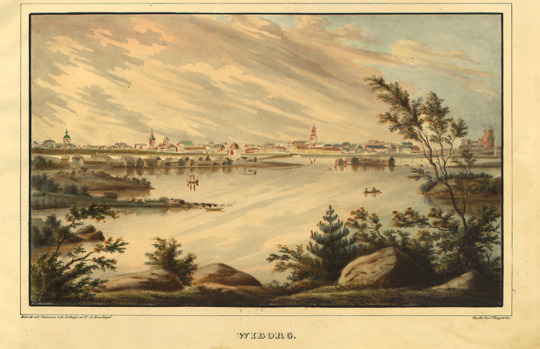
The Vyborg Society House (left), the inn where Anne and Ann stayed in Vyborg (image source). The building was destroyed during the Continuation War.
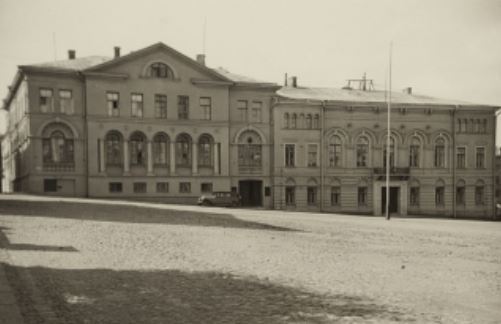
Vyborg around 1938, including the castle and the Fortress Bridge (image source), an earlier (but similar) incarnation of which Anne sketched in her journal in 1839:

The Fortres Bridge in the early 18th century (image source):
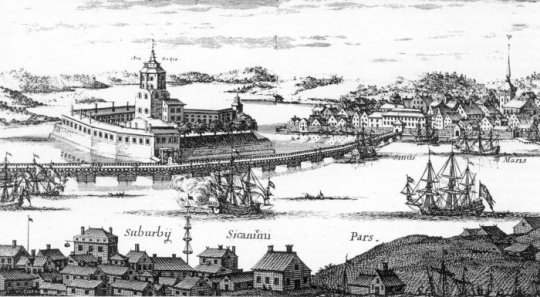
and in Anne’s sketch:

A view of Vyborg Castle, by Torsten Wilhelm Forstén, from 1840, a year after Anne and Ann saw it - and Ann sketched it (image source):

A view of Vyborg bay - “ Ann thought she had never admired a scene more“ (image source):

#anne lister#ann walker#gentleman jack#travelnotes1839#finland1839#russia1839#russianempire1839#annelister#annwalker#anne lister code breaker
13 notes
·
View notes
Photo

“Maison Carrée” temple romain hexastyle (début Ier siècle) à Nîmes, août 2021.
1 note
·
View note
Photo

Villa Foscari “La Malcontenta,” Mira, Italy | Collier Calandruccio
The architecture of Villa Foscari is a masterpiece of formal equilibrium: Palladio designed a perfectly symmetrical, three-story, central-plan building. The forms were inspired by a hexastyle Ionic-order temple.
The first floor of the Villa is decorated with a grand cycle of frescoes by Gian Battista Zelotti (who partnered, on many other works, with Paolo Veronese), with themes drawn mainly from Ovid’s Metamorphosis.
The present owners, descendents of the family that originally commissioned Palladio, completed renovation work begun in 1925 by its then-owner Albert Clinton Landsberg, who had found it in a state of total neglect.
447 notes
·
View notes
Text
Thursday, 13 February 1840
8 1/4
12 40/’’
Breakfast at 9 50/’’ – Before and since till now 10 50/’’ wrote all the 1st 18 lines of yesterday – Very fine morning Reaumur 13 1/2º now at 10 50/’’ a.m. tea and coffee excellent – Slices of smoked bologna saussage – Good – Ready the instant called for – Little cakes on the tray as last night – Slept comfortably –
A servant gone off to Macarief to have the convent open for us – No! The man apparently a sort of under steward, drove off in a Kibitka and pair just before (at the same time with) us, and went about with us everywhere – Reaumur -29º when we set out at 11 25/’’ they call it 5 versts across the river to Macarief – Did not go direct across – But drove along a narrow stream coasting an island for some distance till we turned the point of the island (behind which a little fleet of vessels frozen up) and had the picturesque monastery full in view –
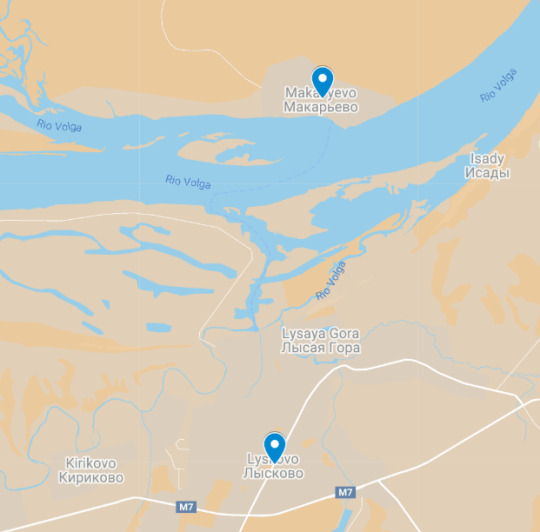
The current geography of the Volga between Lyskovo and Makar’yevo (note the islands in the river).
Walked round, and round towers at the corners – Picturesque square tower gateway in the middle between 2 round towers – The front towards us – And 2 churches with each their 5 domes seen behind the gateway, and a tall handsome pointed clocher – The wooden Town, the natural weathered wood – No paint or wash to brighten it up ∴[therefore] looks old, and unfrequented –
At the monastery in 1/2 hour at 11 55/’’ – A monk in readiness – Shewed us first the winter church – Au 1erpremier (magazines of flour &c. below) low and warm – Shewed us the rich robes de prêtre – And 2 archimandrite caps thick with pearls and a few precious stones – The more valuable worth 20,000/- - then to the summer lofty the walls of the interior entirely covered with fresco painting that wants renewing –
Enormous pillars round up to the top all covered with painting – 4 different chapels at the bottom of each room with gilt columns and baldaquins rich but done about 40 years ago and too modern for the rest of the church – This church shews one that the principal dome and the 2 little domes at the entrance end light the church – The 2 domes at the other end light the part behind the iconostase which generally goes up to the top close under the edge of the great dome – Then to the chapel of St. Macarief – Light, inside all painted over as usual – Pretty chapel – Several pictures representing the history of this Saint born at Nijeni Novgorod –
Then looked about – The great gateway mentioned above has a little church or chapel over it – Saw one of the cells of the monks – A small strip of a room with a less one alongside that held his bed – A stove to heat each – The Archimandrite Abbot could only speak Russian ∴[therefore] sent compliments and did not see him –

The Macarief Convent (image by Alexxx Malev).
An hour there and off at 12 55/’’ A-[Ann] starved drove as near the old site of the Fair as the much snow would let us – A large handsome looking building with the hexastyle or octostyle portico and pediment, and a large pile of other building now made no use of standing in the middle of what used to be surrounded with Q.[Quantum] S.[Satis] of wood erections – The town a mere unpainted village – not a good house to be seen in it –
Drove right across the magnificent river – 1 verst broad just opposite to Macarief, and 10 v.[versts] when debordé – Several islands covered with salley bushes – In 3/4 hour (at 12 40/’’ alighted at the handsome Church of the Assumption finished a year ago built by the Prince of Georgia – Much handsome gilding of colours and handsome grape-pattern prestole doors all done by the prince’s people here – All done by them except the painting some at Moscow of the faces &c. of the pictures – Very pretty church a tetrastyle portico and pediment at each of the 4 (I think) fronts –
Then to the Fabrique of Eau de Vie at 2 5/’’ – Makes 500 hogsheads a year – Besides the 14 mills along the ridge of the hill seen from the river there are 30 or 40 more mills on the platform of this high ground – Went down into a little basin-like hollow to the fabrique – They work up 40 sacks of farine de seigle par jour, and a sack at a rough guess judging from what they said would = at least 5 bushels – They said afterwards they made 25 hogsheads a day i.e. 25 Hogsheads from 40 sacks of flour –
Different qualities of brandi (Vodki) from /60 per bottle to 4/- (about 1 quart bottle – at least 8 of these bottles = 1 vedro and 3 vedros = 1 case (and not less than a case sold here) – I tasted some darkish coloured good mild brandy at 2/50 per bottle and tasted afterwards some of the white hot fiery spirit from the Tuyaux as it ran from the still –
Such a thick fog in the place, could see nothing – All the sides of the wood walls within and everything covered not with flour, but with snow – Singular appearance – The heat of the fabrique and Reaumur -30º of cold without produced this fog and snow within –
Great quantity of Absinthe (Artemisia) hanging up in bundles from the beams of the roof in one of the places – Use this to make what George called bitter brandy – Omitted to ask how many people employed – But saw 1/2 dozen women washing bottles (1/2 as well as 1 quart bottles) and I should think 20 or 30 men in all – They said the hot stuff I saw in troughs dehors and looking thick and yellowish was given to the cows and horses, very fond of it and became fat upon it – I could not see what power turned the great wheel that works the farine with the water in the hujus trough into which it is poured from a sort of hopper – I saw them light a large sort oven or furnace – Is it steam that turns the wheel? I saw no horses anywhere – But perhaps probably horses are employed – Difficult to get information thro’ George –
Then to a machine making shop the Prince bought of Count de Broglie who married a Princess Troubetskoi disagreed with and left her – Returned to France and sold his fabrique – Saw nothing worth going to see there – A few wheels, common turn-wheels – And a large wheel like Jackson’s for turning machinery to make cutlery they said –
A-[Ann] so cold she began to cry ∴[therefore] hurried home and came in at 3 20/’’ then dinner in 10 minutes or less, and over at 4 – Found Porter, Port and 2 White wines on the table and they brought Madeira tasted none of them – And then they brought a 1/2 bottle Rhine wine excellent Stemberger from Cornill Francfort – Then they brought Bishoff (rather too much of the Seville orange in it) then Malaga (refused) then the Maître d’Hotel filled me a glass (A-[Ann] refused) of excellent Champagne, which, as everyone does in Russia, I let stand till the last, and till its upness was gone down then coffee – We had had soup and pâtés – A joint (what?) of veal with a very thin feuille of ham inserted all under the skin! Good – Then côtelettes de veau – Then a rôti of game gelinottes excellent and apparently small squary pieces of veal – Then a sort of little round Savoy Biscuit 2 with preserved whole white currants between – Then preserved white raspberries and preserved thin slices of lemon, all excellent –
Then had George and the Courier settling what to do – Determined to stay all night here, and be off at 6 (6 1/2) in the morning after a cup of tea at 6 – The Courier said that in consequence of (something) horses since Nijeni and forwards will be -/6 each per v.[verst] instead of -/5 – How is this? 8v.[verst] out marche route for tomorrow – The one I had and paid 5/- for the P.[Post] O.[Office] not right for winter and going on the river! –
A[Ann] queer and starved and out of sorts had to get set her right sat some time idle till candles at 6 – And tea at 7 – Before and after wrote note to be left with the Maître d’Hotel tomorrow morning of thanks &c. for ‘À Monsieur le Prince George de Georgie’ and settled accounts and had Domna, and wrote the whole of today till now 11 3/4 p.m. ought to have been in bed – Very fine clear cold day – Reaumur 14º on my table as I sit writing now at 11 3/4 p.m. –
Our room about 9 x 7 yards 2 stoves and 2 doors, and our window in 3 divisions (about 15 square feet of glass) and room perhaps 9 ft.[feet] high – But being so large, it looks low – Very comfortable here – We have about 6 men servants in attendance – 3 sofas, 10 arm and 5 smaller chairs – 2 tables and one little commode, and one out of a nest of tables, and one looking glass nearly 3 ft.[feet] by 18 in.[inches] of mirror and near it the little pénate (household image) – A brick house of no great pretension outside – we have seen no room but this and our anteroom leading to it – But Grâce au Prince George de Georgie for all our comfort and good doings –
[in the margin of the page:] Reaumur -29º
[in the margin of the page:] Macarief
[in the margin of the page:] horses at -/6 from Nijni.
Page References: SH:7/ML/E/24/0013 and SH:7/ML/E/24/0014
6 notes
·
View notes
Video
49010617 par Jean-Fabien JFL
Via Flickr :
photoandlife.tumblr.com/
#Paris#FRANCE#Europe#france miniature#architecture#JFL#photography#photo & life™#SONY#SONY RX1R#SONY DSC-RX1R#RX1R#ZEISS#Carl Zeiss Sonnar 35mm f/2 T*#35mm#black and white#noir et blanc#temple romain hexastyle#Nîmes#Maison Carrée
1 note
·
View note
Text
Thursday 27 February 1840
..
1 40/..
five minutes past one in the morning – Brought over from past page . 141 ½
1 5/.. a.m. to 3 25/.. Chwalinsk [Chvalynsk] to Alexecwna [Alekseevka] 22
3 55/.. to 7 A- to Schirokoy Bouerask [Shirokii Buerak] 29
gorod 7 22/.. to 9 25/.. S- to Wolsck [Vol’sk] breakfast 28 ½
11 22/.. to 1 35/.. W- to Kluci [Kliuchi] 26
2 to 4 38/.. K- to Sinodskoye [Sindskoe] 33 ½
4 55/.. to 7 20/.. S- to Elmanka [Elshanka] 26
306 ½
very fine night or rather morning Alexecwna [Alekseevka] goodish village – at Schirokoy[Shirokii Buerak] at 7 neat good station house (single house government-house) painted yellow with white corners and red roof – 3 nice square rooms on a side – good portico in front with imperial eagle on the pediment, and smaller portico at the back front – large picturesque village we had driven thro’ at a little distance picturesquely spread over the hill or rising ground – sun beautifully rising now at 7 a.m. – beautiful – R-8 ½° at 7 50/.. lying in the open doorway
SH:7/ML/E/24/00027
of our kibitka and sharp cold wind as we drive over this high plain ground - Wolsck [Vol’sk] at 9 25/.. – large good looking town from the river – Enter the town (up steep ravine as usual from the Volga) at 9 5/.. and at the post at the other end of the town at 9 20/.. then calling out breakfast drove back, and at the fair or great marché again – large handsome white new looking Gastinoi [Gostiny] Dvor – a large line of front in the style of the university at Kazan - here the 2 winfs a pedimented tetrastyle the 2 recesses octostyle and the front a pedimented hexastyle – tall Corinthian columns – very handsome building – at the tractir close by the marché and the back court looking down upon and close to the Volga, at 9 25/.. – comfortable enough breakfast – goodish room and plenty of tables – a brick Helsingfors cathedral? church nearly but not quite finished – the scaffolding still up – breakfast at 9 55/.. and over at 11 – to pay what I chose – George said ./50 – I gave 30 S.K. = 1/5 – off at 11 22/.. thro’ the fair – difficulty in getting thro’ the crowd – cold wind – A- soon had her window shut after leaving the town, and begged to have mine shut before long – high plain ground (have we begun with the Steppe?) and sharp wind, made our kibitka when open very cold – wooded range (left) of picturesque rounded undulating broken hill oak-copse and spring wood with some birch, and the Volga behind this hill range – boundless plain to the right – never ending lines of one horse traineaux today as yesterday and always – last ½ our stage to Volsk [Vol’sk] says George was on the Volga – Left the Volga there, and to be on it no more for today? – this station, Kluci [Kliuchi], like the one before Volsk [Vol’sk] a government house – sun shining – large village of Kluci [Kliuchi]? at a little distance – at 3 10/.. soon after passing village with very nice little white church (clocher forming west entrance – nave – the square but domed church tower) we look down upon the Volga? (left) very fine afternoon – sun shining – rather more snow on the ground since Simbirsk – on leaving Wolsk [Vol’sk], noted our rate of driving by the verst-posts and found we went for 3 or 4v. [?] verst in 5 minutes = 12 v. per hour or 12x2÷3 = 8 English miles per hour – fast for Russian horses – the little rough animals seem at great speed – a full trot and occasional hand gallop – the national history museum at Kazan, the only place in Russia where I have seen a want of room! –
a Roadbook of Russian on the plan of Moggs’ on my French Itinéraire a desideratum
St. Petersburg pride of the Romanoff reigning capital of Russia and her Emperors Moscow 2nd capital of Russia and of her Great princes
Kazan capital of Russian Tartary
Kieff [Kiev] eldest capital of Russia, mother of her archives and holy city of her religion
Odessa the Tyre of Russia
Nijni Novgorod [Nižnij Novgorod] Imperial bazaar of Asia and Europe –
at Elmanka [Elshanka] (government house) for the night at 7 20/.. – apparently on the same plan as the other government station houses – but the large rooms not heated – we in a little hot room – but soon made ourselves comfortable – tea and custard as twice before that A- has made of our ten eggs – used the last 4 tonight – glad to be warmly housed – the cold wind in our faces thro’ our unglazed front window not agreeable over the high plain ground – teat 8 – our mattresses on the floor – A- has been laid down (not quite dressed) for perhaps ¼ hour – tis now 1 10/.. tonight just as I have finished from p. 44 et seq. to here – very find cold day – lay down at 1 40/.. –
4 notes
·
View notes
Text
perhaps i’m not allowed to do research into 1830s london anymore, bcos now @ mr jonny sims when will we get a statement about the original london general post office, designed by real-life robert smirke
description of the post office from wikipedia:
It was built in the Grecian style with Ionic porticoes, and was 400 feet (120 m) long and 80 feet (24 m) deep. The building's main facade had a central hexastyle Greek Ionic portico with pediment, and two tetrastyle porticoes without pediments at each end. The main interior was the large letter-carriers' room, with its elegant iron gallery and spiral staircase.
While externally attractive, however, the building suffered from internal shortcomings. Poor layout meant that work requiring bright light was conducted in poorly illuminated areas; odours spread from the lavatories to the kitchens, while the combination of gas lighting and poor ventilation meant that workers often felt nauseous. The expansion of the work of the Post Office also meant that by the later 19th century it was occupied well beyond its intended capacity; The Times reported in 1860 that "rooms have been overcrowded, closets turned into offices, extra rooms hung by tie rods to the girders of the ceiling".
#it was also apparently lit with 1000 gas burners at night#but that's from a different wikipedia article
7 notes
·
View notes
Photo

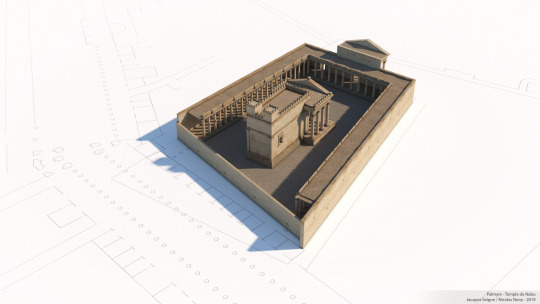





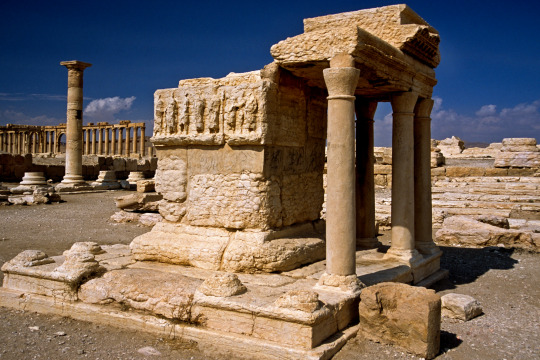



Temple of Nabu
Palmyra (Tadmor), Syria
2nd century CE
The temple was a Corinthian Hexastyle Peripteral temple dedicated to Mesopotamian god of wisdom and writing, and was Eastern in its plan; the outer enclosure's propylaea led to a 20-by-9-metre podium through a portico of which the bases of the columns survives. The peristyle cella opened onto an outdoor altar.
The temple is characterized by its eastern style and architectural and cultural features which still exist at the site, according to Assaf.
He clarified that there are three entrances towards the long street and a main entrance in the southern side, surrounded by corridors and columns with Corinthian crowns with decorations on either side and three rooms directly connected to the inner hallway, which leads to a courtyard with a temple in center.
Sources: 1, 2


#art#Architecture#travel#history#palmyra#nabu#nubu#tadmor#tadmur#syria#temple#lionfront#doric#corinthian#eastern#Hexastyle#Peripteral#2 ce#mythology#mesopotamian#temenos#altar#roman#roman architecture#roman art
162 notes
·
View notes
